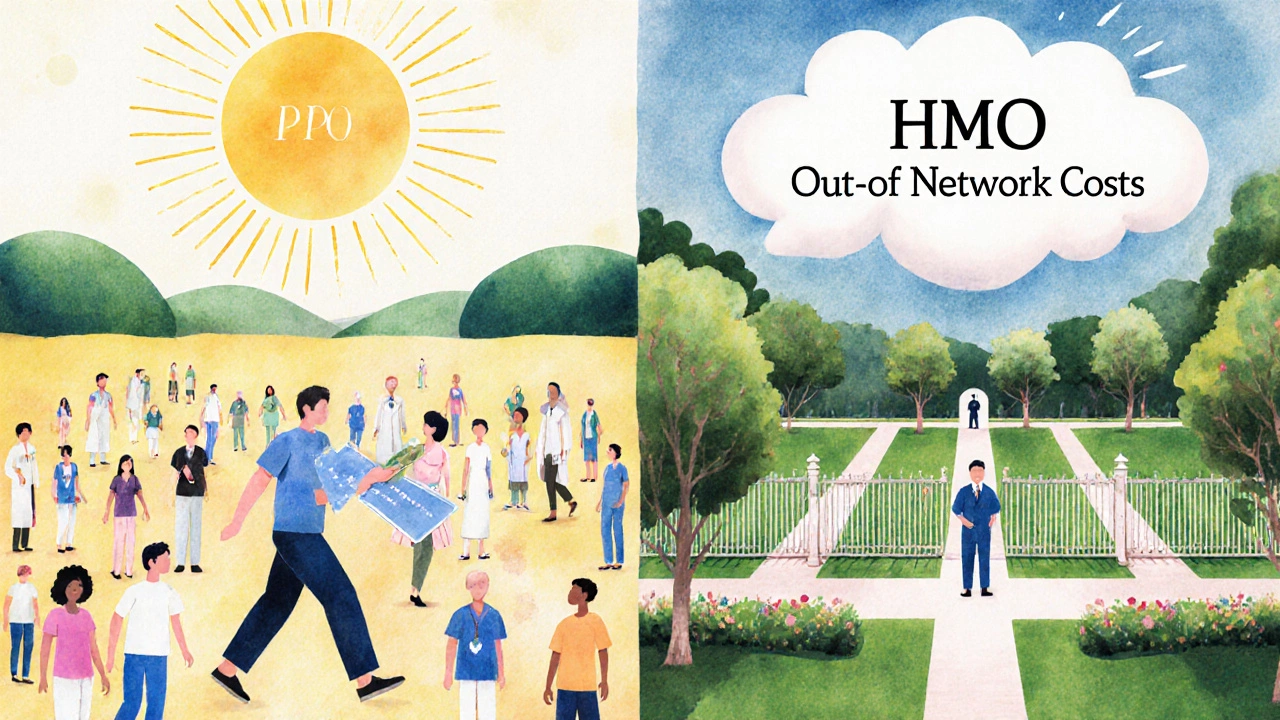HMO vs PPO Cost Calculator
Your Health Usage
Enter your estimated healthcare usage to calculate annual costs
Cost Breakdown
Your inputs will be compared against standard HMO and PPO costs
| Cost Type | HMO | PPO |
|---|---|---|
| Primary Care Visit | $20 | $40 |
| Specialist Visit | $40 | $60 |
| Prescription (generic) | $10 | $20 |
| Deductible | $0-$500 | $1,000-$2,500 |
Choosing between a PPO and an HMO isn’t just about paperwork-it’s about how you get care, who you see, and how much it costs when you need it. If you’ve ever stared at a health insurance brochure and felt lost, you’re not alone. Millions of people in the U.S. and private healthcare markets abroad face this exact choice every year. And the wrong pick can mean longer waits, surprise bills, or being stuck with a doctor you don’t like.
What Is an HMO?
An HMO, or Health Maintenance Organization, is a type of health plan that keeps things simple-but with rules. You pick one primary care doctor (PCP) from a network of providers. That doctor becomes your main point of contact for everything: colds, checkups, even referrals to specialists. If you want to see a cardiologist or dermatologist, your PCP has to give you a referral first. No referral? The visit likely won’t be covered.
HMOs limit you to in-network providers. If you go outside the network for non-emergency care, you pay 100% out of pocket. That means if you travel often or live near a state border, you could lose access to your usual doctors. But in return, HMOs usually have lower monthly premiums and lower out-of-pocket costs for services inside the network.
For example, a typical HMO might charge you $20 for a doctor visit and $10 for a generic prescription. Annual deductibles are often $0. That’s appealing if you don’t need frequent specialist care and prefer predictable costs.
What Is a PPO?
A PPO, or Preferred Provider Organization, gives you more freedom. You don’t need a referral to see a specialist. Want to go straight to an orthopedist for your knee pain? Go ahead. Need to see a dermatologist you found online? You can book the appointment yourself.
PPOs still have a network of preferred providers-you’ll pay less if you stay in-network. But unlike HMOs, you can go outside the network and still get some coverage. It won’t be as cheap, but you won’t be stuck paying everything yourself. For instance, an out-of-network MRI might cost you $800 instead of $300 if you’d stayed in-network.
PPOs usually come with higher monthly premiums. You might pay $300-$500 a month compared to $150-$250 for an HMO. You’ll also likely have a deductible-maybe $1,500 or more-before insurance kicks in. But if you value flexibility, travel often, or have a chronic condition that requires frequent specialist visits, the extra cost can be worth it.
Cost Comparison: HMO vs PPO
Here’s how typical costs stack up in 2025 for an individual plan:
| Cost Type | HMO | PPO |
|---|---|---|
| Monthly Premium | $180 | $380 |
| Annual Deductible | $0-$500 | $1,000-$2,500 |
| Primary Care Visit (in-network) | $20 | $40 |
| Specialist Visit (in-network) | $40 | $60 |
| Out-of-Network Coverage | No | Yes, at 50-70% |
| Prescription Copay (generic) | $10 | $20 |
Let’s say you need to see a specialist twice a year and get one MRI. With an HMO, you’d pay $80 for the visits and maybe $300 for the MRI (in-network). Total: $380. With a PPO, you’d pay $120 for visits, $800 for the MRI (out-of-network), and $1,500 deductible-so you’d pay $2,420 before insurance helps. But if you had stayed in-network for the MRI, it’d drop to $300, making your total $540. That’s still more than the HMO, but you had the choice to go out-of-network if needed.
When Should You Choose an HMO?
Choose an HMO if:
- You’re generally healthy and don’t see specialists often
- You want the lowest possible monthly bill
- You’re okay with a gatekeeper system-your PCP controls your care
- You live in one area and don’t travel frequently
- You prefer predictable, low out-of-pocket costs
HMOs work well for families with kids, retirees on fixed incomes, or anyone who doesn’t mind sticking to a single provider network. Many employers offer HMOs as their default plan because they’re cheaper to administer.

When Should You Choose a PPO?
Choose a PPO if:
- You see multiple specialists regularly (e.g., for diabetes, back pain, or mental health)
- You travel often or split time between cities
- You want the freedom to choose any doctor without referrals
- You’ve had bad experiences with HMO referrals being denied or delayed
- You’re willing to pay more upfront for flexibility
PPOs are common among freelancers, remote workers, people with chronic conditions, and those who value control over their care. If you’ve ever waited six weeks for a specialist referral only to find the provider wasn’t accepting new patients, you’ll appreciate the PPO’s direct access.
What You Can’t Do With Either Plan
Neither HMOs nor PPOs cover everything. Both exclude:
- Experimental treatments not approved by the FDA
- Most cosmetic procedures (like elective rhinoplasty or Botox)
- Long-term care (nursing homes, in-home aides)
- International medical care outside emergency situations
Also, both require you to use in-network providers to get the best rates. Always check your plan’s provider directory before booking an appointment-even if the doctor says they accept your insurance, their network status can change without notice.
Common Myths About HMOs and PPOs
Myth: HMOs are lower quality.
Reality: Quality depends on the provider, not the plan type. Many top-rated hospitals and clinics operate within HMO networks. The difference is access, not care quality.
Myth: PPOs always cost more.
Reality: If you rarely use healthcare, an HMO saves you money. But if you need frequent care, a PPO’s out-of-network option can prevent catastrophic bills.
Myth: You can’t switch plans easily.
Reality: Most people can switch during open enrollment (usually November-December). Some employers allow changes after major life events like marriage, having a baby, or losing other coverage.

How to Decide: A Quick Checklist
Ask yourself these five questions:
- Do I see specialists often without referrals? → If yes, pick PPO.
- Do I travel or live in multiple places? → If yes, pick PPO.
- Do I want the lowest monthly bill? → If yes, pick HMO.
- Am I okay with my doctor deciding who I see? → If yes, pick HMO.
- Do I have a chronic condition that needs ongoing specialist care? → If yes, pick PPO.
If you answered yes to two or more PPO-friendly questions, go with a PPO. If you answered yes to three or more HMO-friendly questions, stick with an HMO.
What Happens If You Go Outside the Network?
With an HMO: You pay 100%. No exceptions. Even if you’re in a car accident and taken to the nearest ER, if it’s out-of-network, you could be billed for the full cost-unless it’s a true emergency. Most HMOs cover emergency care regardless of location.
With a PPO: You pay more, but not everything. You’ll likely pay a higher coinsurance rate-say 40% instead of 20%. You’ll also have to file claims yourself and wait for reimbursement. It’s doable, but it’s more work.
Pro tip: Always call your insurer before seeing a new doctor. Ask: "Is this provider in-network?" and "What’s my cost if I go out-of-network?" It takes two minutes and can save you hundreds.
Final Thoughts
There’s no "best" plan-only the best plan for your life. An HMO is like a guided tour: structured, affordable, and efficient. A PPO is like renting a car: you pay more, but you can go anywhere you want.
If you’re young and healthy, an HMO might be the smart move. If you’re managing a condition, traveling often, or just hate bureaucracy, a PPO gives you breathing room. The key is knowing your own health needs-not what the brochure says.
Review your options every year during open enrollment. Your needs change. Your plan should too.
Can I switch from an HMO to a PPO during the year?
Generally, no. You can only switch during open enrollment, which usually runs from November to December. But exceptions exist if you have a qualifying life event-like getting married, having a baby, losing your job, or moving to a new state. You typically have 30 to 60 days after the event to make the change. Always check with your employer or insurer to confirm.
Do HMOs have better customer service than PPOs?
Not necessarily. Customer service depends on the insurance company, not the plan type. Some HMOs are known for fast responses because they manage care tightly. Some PPOs have long wait times because they handle more complex billing. Look at reviews for the specific insurer, not the plan name.
Can I have both an HMO and a PPO at the same time?
No. You can’t have two active health insurance plans from the same insurer at once. But you can have one plan from your employer and a separate plan through a spouse or private purchase. In that case, one becomes primary and the other secondary. The secondary plan may cover costs the primary didn’t pay, but it won’t let you bypass network rules.
Are mental health services covered the same in HMOs and PPOs?
Under U.S. federal law, mental health coverage must be equal to physical health coverage in both HMOs and PPOs. But in practice, HMOs often require referrals for therapists or psychiatrists, while PPOs let you book directly. Also, PPOs usually have a wider network of mental health providers, especially for specialists like child psychologists or addiction counselors.
What if my doctor leaves the network?
Your insurer must notify you in writing at least 30 days before your provider drops out. If you’re in the middle of treatment-like chemotherapy or physical therapy-you may be allowed to continue seeing them for a limited time under a "continuity of care" rule. Contact your insurer immediately to find out your options and get help finding a new in-network provider.
Do PPOs cover out-of-network emergency care?
Yes. Both HMOs and PPOs are required by law to cover emergency care no matter where you are. That includes ER visits, ambulance rides, and urgent care for life-threatening conditions. But non-emergency care-like a follow-up visit after an ER trip-must be done in-network to avoid high costs.
Is a PPO worth it if I rarely go to the doctor?
Probably not. If you only go for annual checkups and occasional colds, the higher premiums and deductibles of a PPO won’t pay off. An HMO with low premiums and no deductible will save you money. Save the PPO flexibility for when you actually need it.
Next Steps
Before you sign up:
- Check your employer’s plan options-many offer both HMO and PPO choices.
- Look up your current doctors in the insurer’s provider directory. If they’re not in-network, you’ll have to switch.
- Calculate your expected annual costs: premiums + estimated visits + prescriptions.
- Ask your insurer: "What’s the maximum I’d pay in a year?" That’s your out-of-pocket maximum.
Don’t choose based on price alone. Choose based on what you’ll actually use-and what you can’t live without.




